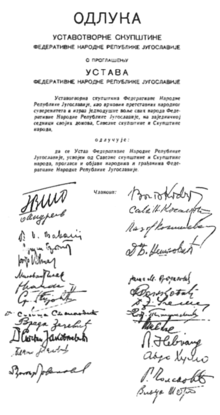1946 Yugoslav Constitution

The 1946 Yugoslav Constitution was the first constitution of the Federal People's Republic of Yugoslavia. It came into effect at its promulgation on January 31.
Commentary
In his address to the Fifth Congress of the Communist Party of Yugoslavia, President Josip Broz Tito referred to several articles of the Constitution to demonstrate its liberal nature.
Let us take only Article 1 of the Constitution, which says: "The Federal People's Republic of Yugoslavia is a federal national state of republican structure, a community of peoples enjoying equal rights, who on the basis of the right to self-determination, including the right to secede, have expressed their will to live together in a federated state."
There, that is how national equality is settled here, that is how it is codified and put fully into practice.
Consequently, the Constitution has only confirmed, or rather codified, what was won during the war, that is to say the power of the people, the power of a real people's democracy.[1]
Further, how is the question of power settled in the Constitution and in practice in this country?
In Article 6 it is stated: "In the Federal People's Republic of Yugoslavia all power derives from the people and belongs to the people. The people exercise their power through the freely elected representative bodies of state authority, from the people's committees which, from the local people's committees up to the assemblies of the people's republics and the People's Assembly of the Federal People's Republic of Yugoslavia originated and developed in the People's Liberation War against Fascism and reaction and which are the basic achievements of that struggle."
Regulations
The breakdown of the Federal People's Republic of Yugoslavia was realized by the declaration of federal organization and by that, six new nations and two autonomous regions were born. The doctrine of the three-national people was abandoned and the status of a nation was given to the Macedonians (ethnic group), Montenegrins and Bosnian Muslims.
The second important characteristic is that it resembles the constitution of the Soviet Union in the year 1936 (AKA "The Stalin's Constitution"). The constitution contained regulations about the dominant position of state property, organization of authority on the principle of unity of authority and dichotomous division of all state authority on state authorities and state administration.
The division of jurisdiction existed between the union state, the member republics, the territorial administration and local administration. On the same level of authority existed the principle of authority union, and the vertical regulation was based on the principle of "democratic centralism", which was defined by the leading constitution maker of that time: Edvard Kardelj. That actually meant the introduction of the etatist social and centralist state regulation even side by side with the nominal federalism. Ideological, political and other forms of pluralism were excluded.
Practice
This Constitution will enable further firming of the new authorities in the country, but soon after that, the process of changing the Constitution will begin as the result of a conflict with the Soviet Union, until recently ally and model. The Yugosloven trip into Socialism will begin with Constitution changes in the years 1950 and 1952, and a major change will be made in the 1953 Yugoslav Constitution.
References
- ↑ Christman, Henry M., ed. The Essential Tito. St. Martin's Press, 1970, p. 56
External links
- 1946 Yugoslav Constition at worldstatesmen.org